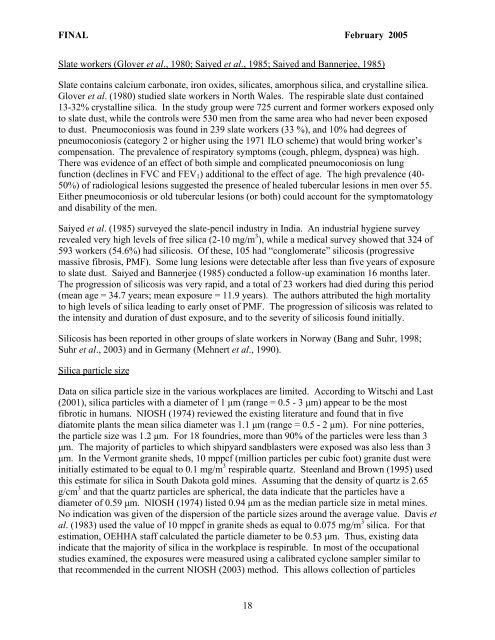Silica (crystalline, respirable) - OEHHA
Silica (crystalline, respirable) - OEHHA
Silica (crystalline, respirable) - OEHHA
You also want an ePaper? Increase the reach of your titles
YUMPU automatically turns print PDFs into web optimized ePapers that Google loves.
FINAL February 2005<br />
Slate workers (Glover et al., 1980; Saiyed et al., 1985; Saiyed and Bannerjee, 1985)<br />
Slate contains calcium carbonate, iron oxides, silicates, amorphous silica, and <strong>crystalline</strong> silica.<br />
Glover et al. (1980) studied slate workers in North Wales. The <strong>respirable</strong> slate dust contained<br />
13-32% <strong>crystalline</strong> silica. In the study group were 725 current and former workers exposed only<br />
to slate dust, while the controls were 530 men from the same area who had never been exposed<br />
to dust. Pneumoconiosis was found in 239 slate workers (33 %), and 10% had degrees of<br />
pneumoconiosis (category 2 or higher using the 1971 ILO scheme) that would bring worker’s<br />
compensation. The prevalence of respiratory symptoms (cough, phlegm, dyspnea) was high.<br />
There was evidence of an effect of both simple and complicated pneumoconiosis on lung<br />
function (declines in FVC and FEV1) additional to the effect of age. The high prevalence (40-<br />
50%) of radiological lesions suggested the presence of healed tubercular lesions in men over 55.<br />
Either pneumoconiosis or old tubercular lesions (or both) could account for the symptomatology<br />
and disability of the men.<br />
Saiyed et al. (1985) surveyed the slate-pencil industry in India. An industrial hygiene survey<br />
revealed very high levels of free silica (2-10 mg/m 3 ), while a medical survey showed that 324 of<br />
593 workers (54.6%) had silicosis. Of these, 105 had “conglomerate” silicosis (progressive<br />
massive fibrosis, PMF). Some lung lesions were detectable after less than five years of exposure<br />
to slate dust. Saiyed and Bannerjee (1985) conducted a follow-up examination 16 months later.<br />
The progression of silicosis was very rapid, and a total of 23 workers had died during this period<br />
(mean age = 34.7 years; mean exposure = 11.9 years). The authors attributed the high mortality<br />
to high levels of silica leading to early onset of PMF. The progression of silicosis was related to<br />
the intensity and duration of dust exposure, and to the severity of silicosis found initially.<br />
Silicosis has been reported in other groups of slate workers in Norway (Bang and Suhr, 1998;<br />
Suhr et al., 2003) and in Germany (Mehnert et al., 1990).<br />
<strong>Silica</strong> particle size<br />
Data on silica particle size in the various workplaces are limited. According to Witschi and Last<br />
(2001), silica particles with a diameter of 1 µm (range = 0.5 - 3 µm) appear to be the most<br />
fibrotic in humans. NIOSH (1974) reviewed the existing literature and found that in five<br />
diatomite plants the mean silica diameter was 1.1 µm (range = 0.5 - 2 µm). For nine potteries,<br />
the particle size was 1.2 µm. For 18 foundries, more than 90% of the particles were less than 3<br />
µm. The majority of particles to which shipyard sandblasters were exposed was also less than 3<br />
µm. In the Vermont granite sheds, 10 mppcf (million particles per cubic foot) granite dust were<br />
initially estimated to be equal to 0.1 mg/m 3 <strong>respirable</strong> quartz. Steenland and Brown (1995) used<br />
this estimate for silica in South Dakota gold mines. Assuming that the density of quartz is 2.65<br />
g/cm 3 and that the quartz particles are spherical, the data indicate that the particles have a<br />
diameter of 0.59 µm. NIOSH (1974) listed 0.94 µm as the median particle size in metal mines.<br />
No indication was given of the dispersion of the particle sizes around the average value. Davis et<br />
al. (1983) used the value of 10 mppcf in granite sheds as equal to 0.075 mg/m 3 silica. For that<br />
estimation, <strong>OEHHA</strong> staff calculated the particle diameter to be 0.53 µm. Thus, existing data<br />
indicate that the majority of silica in the workplace is <strong>respirable</strong>. In most of the occupational<br />
studies examined, the exposures were measured using a calibrated cyclone sampler similar to<br />
that recommended in the current NIOSH (2003) method. This allows collection of particles<br />
18















